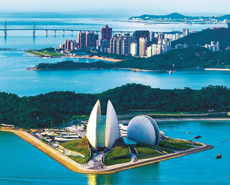Diversified magnesium products enhance competition
----Interview with Yuan Sanfei
Vice President
Fuguxian Boland C Magnesium Electric Co., Ltd.
Set up in November 2007 and located in Fugu County, Shaanxi Province, Fuguxian Boland C Magnesium Electric Co., Ltd. has an annual production capacity of 980,000t of semi-coke, 30,000t of activated carbon, 20,000t of magnesium ingot and 370,000t of baking-free brick, and has raw coal cleaning/dressing equipment of 1.2 million ton capacity and two 25,000KVA ferrosilicon furnaces. By adopting delicacy management strategy to build its core competitive strengths, the company aims to achieve a sustainable development model and to build itself a leading light in the magnesium market.
Asian Metal: Thanks for taking our interview, Mr. Yuan. Would you please give a brief introduction about the latest development of your company?
Mr. Yuan: Thanks. I am glad to have the opportunity to be interviewed by Asian Metal. Our company is mainly engaged in businesses related to magnesium ingot and has an annual designed production capacity of 20,000t. Running at full capacity we are able to produce 1,800tpm of the material, and at present, as prices for raw material ferrosilicon are high but prices for magnesium ingot hover at a low level, we cut our operating rate and the monthly output drops to 1,000t.
Asian Metal: During the first half of 2017 there were only small fluctuations occurring in prices for magnesium ingot. But entering the latter of this year, prices experienced vehement fluctuations, rocketing in August, plunging sharply in September and hovering at a low level since October. Some magnesium plants even claim that they are ready to face a dim outlook that prices for magnesium ingot might go down to below their production costs. What do you think is the reason for those price fluctuations?
Mr. Yuan: I think that price fluctuations for magnesium ingot in 2017, no matter up or down, are mainly affected by those for raw material ferrosilicon. In August, as spot supply of ferrosilicon was tight while demand from steel mills was strong, its prices surged all the way to RMB9,000/t (USD1,362/t) EXW D/A. During the process, prices for magnesium ingot followed suit to go up to RMB17,800-18,000/t (USD2,694-2,724/t) EXW D/P. But as demand for magnesium ingot was weak and moreover, supply of the material was in a surplus state on the whole, there were limited transactions concluded at high prices in the market as a result and stocks of magnesium plants increased. Since September, ferrosilicon producers increased their operating rates and some shutdown ferrosilicon plants resumed production too; so supply of the material amounted in the market and its prices began to go down. Affected by this and also by weak demand for magnesium ingot, prices for magnesium ingot began to go down since September and dropped to the level of RMB14,000-14,100/t (USD2,119-2,134/t) EXW D/P in late September. Most magnesium plants in Shanxi, Ningxia, Inner Mongolia and Xinjiang were racked with the fact that prices for their materials were even lower than their production costs, and some Shaanxi-based magnesium plants which maintained relatively high financial costs also became profitless. Entering October, except in Shaanxi, there were a number of magnesium plants in all other provinces which suspended production or cut outputs; but as stocks in the market were still of great quantities and plants running at that time maintained relatively high operating rates, the Chinese market still witnessed oversupply of magnesium ingot. After that, prices for the material lingered at a low level and buyers just maintained minimum purchases. As transactions were rare, magnesium plants kept large quantities of stocks in hand and thus faced great pressure in making sales. Generally speaking, the ultimate reason for magnesium ingot prices standing at a low level is still the weak demand and oversupply.
Asian Metal: Affected by vehement competition in prices, magnesium plants in Shanxi, Inner Mongolia and Xinjiang suspend production or cut outputs to various extents, while most Shaanxi-based magnesium plants maintain stable production and relatively high operating rates. What do you think are the advantages of Shaanxi plants?
Mr. Yuan: Compared with production costs at present, magnesium plants in Shanxi, Inner Mongolia and Xinjiang suffer losses of over RMB1,000/t (USD151/t) for magnesium ingot. But some magnesium plants in Shaanxi are still able to maintain a certain profit margin, thanks to their advantage in energy supply and to the fact that they have their own ferrosilicon plants, but other magnesium plants which have to purchase ferrosilicon outside in the market also keep high production costs. This year, our company still makes satisfactory sales; meanwhile, we still boast advantages in energy supply. So we are unlikely to suffer too great losses. In addition, in order to avoid freezing and rupture of production equipment which often happen when production is suspended, most magnesium plants in Shaanxi are still striving to maintain operation now.
Asian Metal: After the closing of CPC 19th National Congress, insiders attach more attention to environmental protection. How do you think of impacts from environmental protection policies upon Shaanxi-based magnesium plants?
Mr. Yuan: After the congress, government strengthens its administration on environmental protection, imposing much stricter requirements upon industrial enterprises. As a magnesium producer in Shaanxi, we produce magnesium ingots by recycling tail gas from semi-coke production process, and therefore our integrated production model assures us that our production meets up with environmental requirements. In addition, we have all required desulfuration and denitration equipment so that our production is not disturbed by environmental inspections. Of course, if there are new environmental requirements appearing, we surely will adopt necessary measures to meet up with them.
Asian Metal: Under such a background of oversupply of homogenized magnesium ingot products and vehement competition among low-priced products, how do you do to enhance your competitive strengths?
Mr. Yuan: At present, the magnesium ingot market sees a quite serious oversupply of ordinary 7.5kg-type products. And also because of weak demand in the recent period and accordingly amounting stocks, we begin to produce new types of magnesium ingot, including T type and 99.95B type, in order to avoid competition between homogenized products. After next Spring Festival, we will begin to produce new types of magnesium ingot such as 110g and 300g types. In addition, besides selling in the spot market, we are considering to establish long-term cooperative partnership with a number of end consumers to maintain stable sales.
Asian Metal: How do you think of price trend for magnesium ingot in late November and December? Do you think it’s possible for prices to turn around in the first quarter of 2018?
Mr. Yuan: Though ferrosilicon prices continuously stood at a high level, prices for magnesium ingot bore downward pressure and went down slightly in late November, a result from weak demand and high stocks held by magnesium plants. At the same time, buyers stopped watching and began to make hand-to-mouth purchases, and accordingly transactions in the market increased and magnesium plants felt less pressure. Entering December, as stocks held by magnesium plants decline to some extent and ferrosilicon prices are still high, magnesium plants slightly raise their prices for magnesium ingot to check market responses. On the whole, this recent price upward movement is limited to the range of RMB200-300/t (USD30.27-45.40/t); most buyers just make hand-to-mouth purchases and there are only a few clients setting out to rebuild their stocks. It will still be difficult for magnesium ingot prices to turn around notably. As the 2018 Spring Festival falls in February, magnesium plants are likely to make sales actively in January in order to recoup funds and to cut their stocks. So some plants may cut their prices in order to promote sales during that time and most overseas buyers are expected to restock the material, leading to a large number of transactions to be concluded. During February, the magnesium ingot market is expected to run stably and prices to remain stable on the whole. Entering March, with players returning to the market, transactions might pick up gradually to prop up prices for the material.
Asian Metal: Thanks again for taking our interview. Wish your company better development in the future.
Mr. Yuan: Thanks. We also hope that Asian Metal sticks to the principle of objectiveness and timeliness to serve clients with better information about the magnesium market.
















